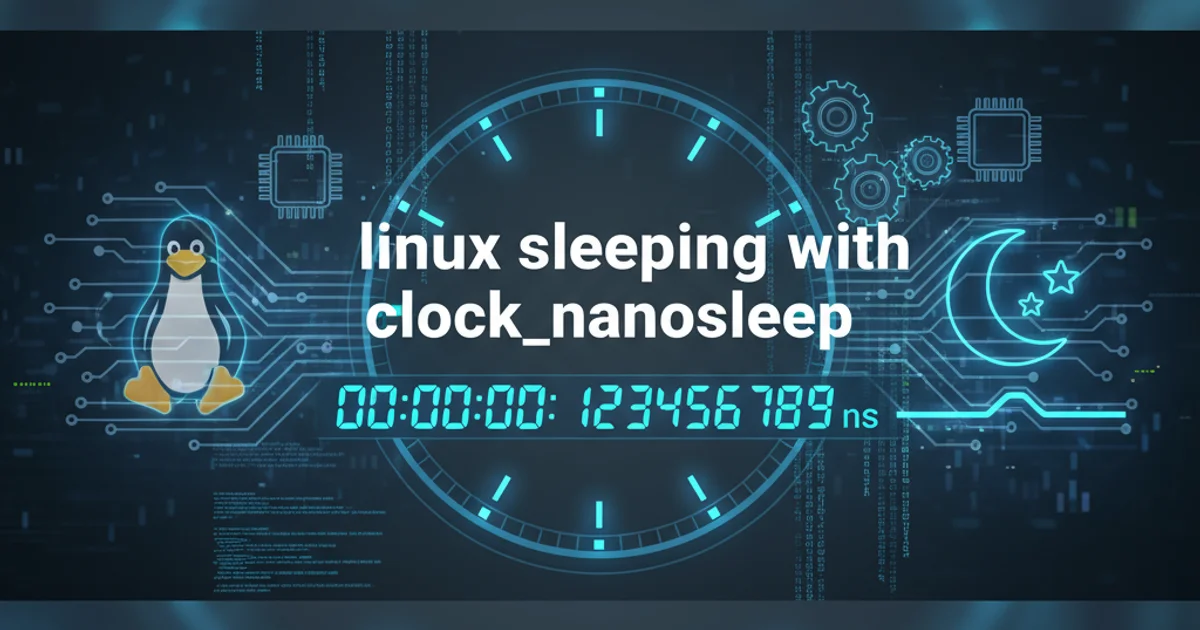linux sleeping with clock_nanosleep
Categories:
Precise Sleeping in Linux with clock_nanosleep

Explore how to achieve high-resolution, interruptible delays in Linux using the clock_nanosleep function, a powerful alternative to sleep and usleep for C++ applications.
In many real-time or performance-critical Linux applications, precise timing and controlled delays are essential. While sleep() and usleep() provide basic pausing functionality, they often lack the precision and flexibility required for modern systems. This article delves into clock_nanosleep, a more robust and granular function for introducing delays in your C++ programs, offering nanosecond resolution and interruptibility.
Why clock_nanosleep?
Traditional sleeping functions like sleep() (seconds) and usleep() (microseconds) are often implemented using select() or poll() internally, which can introduce overhead and may not guarantee the requested delay with high accuracy, especially for very short durations. They also typically cannot be interrupted by signals, making them less suitable for responsive applications.
clock_nanosleep, on the other hand, allows you to specify delays with nanosecond precision and offers the crucial ability to be interrupted by signals. This makes it ideal for scenarios where your application needs to pause for a very specific duration but also remain responsive to external events or termination requests.
flowchart TD
A[Start Application] --> B{Need to pause?}
B -- Yes --> C[Calculate `timespec` for delay]
C --> D{Call `clock_nanosleep`}
D -- Signal Received --> E[Handle Signal & Resume/Exit]
D -- Delay Completed --> F[Resume Application Logic]
E --> F
F --> B
B -- No --> G[Continue Processing]
G --> BWorkflow illustrating the use of clock_nanosleep with signal handling.
Understanding clock_nanosleep Parameters
The clock_nanosleep function has the following signature:
int clock_nanosleep(clockid_t clock_id, int flags, const struct timespec *request, struct timespec *remain);
Let's break down its parameters:
clock_id: Specifies the clock to use. Common choices includeCLOCK_REALTIME(system-wide wall-clock time) andCLOCK_MONOTONIC(a non-decreasing clock, unaffected by system time changes, ideal for measuring intervals).flags: Controls the behavior of the sleep. The most important flag isTIMER_ABSTIME. If set,requestspecifies an absolute time to wake up. If not set (i.e.,flagsis 0),requestspecifies a relative duration to sleep.request: A pointer to astruct timespecthat defines the sleep duration or wake-up time.struct timespechas two fields:tv_sec(seconds) andtv_nsec(nanoseconds).remain: Ifclock_nanosleepis interrupted by a signal, this pointer will be populated with the remaining time that was not slept. This allows you to resume sleeping for the remaining duration if desired. IfNULL, the remaining time is not returned.
CLOCK_MONOTONIC is preferred over CLOCK_REALTIME because it's immune to system time adjustments (e.g., NTP updates), ensuring consistent delay durations.Practical Example: Relative Sleep with Signal Handling
Here's a C++ example demonstrating how to use clock_nanosleep for a relative delay, incorporating basic signal handling to allow interruption.
#include <iostream>
#include <ctime>
#include <csignal>
#include <chrono>
volatile sig_atomic_t keep_running = 1;
void signal_handler(int signum) {
std::cout << "\nSignal " << signum << " received. Exiting sleep.\n";
keep_running = 0;
}
int main() {
// Register signal handler for SIGINT (Ctrl+C)
std::signal(SIGINT, signal_handler);
std::cout << "Sleeping for 5 seconds (relative) with nanosecond precision. Press Ctrl+C to interrupt.\n";
struct timespec request;
request.tv_sec = 5; // 5 seconds
request.tv_nsec = 0; // 0 nanoseconds
struct timespec remaining;
int ret;
auto start_time = std::chrono::high_resolution_clock::now();
while (keep_running) {
ret = clock_nanosleep(CLOCK_MONOTONIC, 0, &request, &remaining);
if (ret == 0) {
// Sleep completed successfully
std::cout << "Sleep completed without interruption.\n";
break;
} else if (ret == EINTR) {
// Interrupted by a signal
std::cout << "Sleep interrupted by signal. Remaining time: "
<< remaining.tv_sec << "s, " << remaining.tv_nsec << "ns.\n";
// Optionally, you could re-sleep for the remaining time:
// request = remaining; // Set request to remaining time
// continue; // Loop again to sleep for remaining time
break; // For this example, we just exit
} else {
// Other error
perror("clock_nanosleep");
break;
}
}
auto end_time = std::chrono::high_resolution_clock::now();
std::chrono::duration<double, std::milli> elapsed = end_time - start_time;
std::cout << "Actual elapsed time: " << elapsed.count() << " ms.\n";
return 0;
}
C++ code demonstrating clock_nanosleep for a 5-second relative delay, interruptible by Ctrl+C.
Absolute vs. Relative Sleep
The flags parameter is crucial for determining whether clock_nanosleep performs a relative or absolute sleep.
- Relative Sleep (flags = 0): The function pauses for the duration specified in
request. If interrupted,remainwill hold the time left to sleep. - Absolute Sleep (flags =
TIMER_ABSTIME): The function pauses until the system clock (specified byclock_id) reaches the time specified inrequest. This is particularly useful for synchronizing events to a specific point in time, rather than just waiting for an interval. If interrupted,remainis still populated with the time remaining until the absolute wake-up time.
When using TIMER_ABSTIME, you typically need to get the current time using clock_gettime() and add your desired delay to it to calculate the target wake-up time.
TIMER_ABSTIME with CLOCK_REALTIME, be aware that system time changes (e.g., daylight saving adjustments, NTP synchronization) can affect your wake-up time. For precise, interval-based delays, CLOCK_MONOTONIC is generally safer.Compiling and Running
To compile the example code, you typically don't need any special flags beyond the standard C++ compiler:
g++ -std=c++17 -o nanosleep_example nanosleep_example.cpp
./nanosleep_example
When running, try pressing Ctrl+C during the sleep period to observe the signal handling in action.